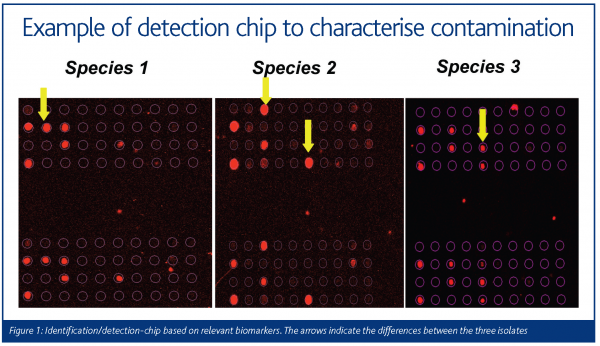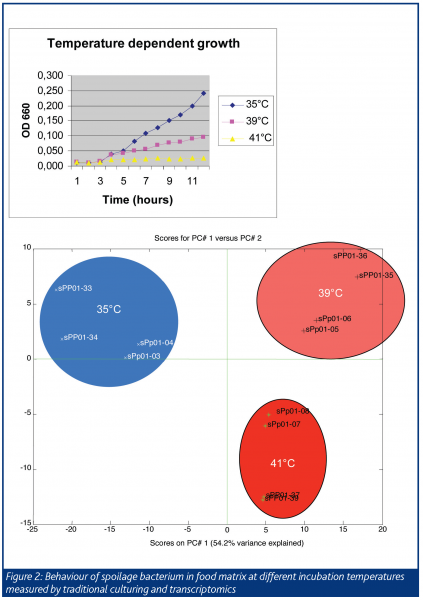Genomics in microbial food quality and safety
- Like
- Digg
- Del
- Tumblr
- VKontakte
- Buffer
- Love This
- Odnoklassniki
- Meneame
- Blogger
- Amazon
- Yahoo Mail
- Gmail
- AOL
- Newsvine
- HackerNews
- Evernote
- MySpace
- Mail.ru
- Viadeo
- Line
- Comments
- Yummly
- SMS
- Viber
- Telegram
- Subscribe
- Skype
- Facebook Messenger
- Kakao
- LiveJournal
- Yammer
- Edgar
- Fintel
- Mix
- Instapaper
- Copy Link
Posted: 29 July 2005 | Jos van der Vossen, Frank Schuren and Roy Montijn, TNO Quality of Life, The Netherlands | No comments yet
The food industry is assisted optima forma when a clear and rapid insight could be given into the presence and behavior of microorganisms in ingredients, processing, final product and health. A clear insight regarding the microbiology of food products and production is essential for prediction and management of food quality and safety.
State of the art
Insight into microbial issues is – to date – dependent on culturing, genetic typing and PCR detection. However, the information collected with these methods is highly restricted, yet inherent to the setup of methods for detection. The methods of detection are generally directed towards groups of microbes such as Salmonella, Campylobacter, lactic acid bacteria, yeasts etc. It is obvious that really important information such as virulence and resistance to preservatives, low water activity and heat is ignored by this rough way of grouping. Such information only becomes available after isolation and subsequent physiological studies. The time needed for collecting the limited amount of information is enormous and does not meet the required response for quality management. Even PCR detection, which is rapid in itself, still needs a time consuming pre-culturing step in order to meet the need for sensitivity.
The food industry is assisted optima forma when a clear and rapid insight could be given into the presence and behavior of microorganisms in ingredients, processing, final product and health. A clear insight regarding the microbiology of food products and production is essential for prediction and management of food quality and safety. State of the art Insight into microbial issues is – to date – dependent on culturing, genetic typing and PCR detection. However, the information collected with these methods is highly restricted, yet inherent to the setup of methods for detection. The methods of detection are generally directed towards groups of microbes such as Salmonella, Campylobacter, lactic acid bacteria, yeasts etc. It is obvious that really important information such as virulence and resistance to preservatives, low water activity and heat is ignored by this rough way of grouping. Such information only becomes available after isolation and subsequent physiological studies. The time needed for collecting the limited amount of information is enormous and does not meet the required response for quality management. Even PCR detection, which is rapid in itself, still needs a time consuming pre-culturing step in order to meet the need for sensitivity.
The food industry is assisted optima forma when a clear and rapid insight could be given into the presence and behavior of microorganisms in ingredients, processing, final product and health. A clear insight regarding the microbiology of food products and production is essential for prediction and management of food quality and safety.
State of the art
Insight into microbial issues is – to date – dependent on culturing, genetic typing and PCR detection. However, the information collected with these methods is highly restricted, yet inherent to the setup of methods for detection. The methods of detection are generally directed towards groups of microbes such as Salmonella, Campylobacter, lactic acid bacteria, yeasts etc. It is obvious that really important information such as virulence and resistance to preservatives, low water activity and heat is ignored by this rough way of grouping. Such information only becomes available after isolation and subsequent physiological studies. The time needed for collecting the limited amount of information is enormous and does not meet the required response for quality management. Even PCR detection, which is rapid in itself, still needs a time consuming pre-culturing step in order to meet the need for sensitivity.
The behaviour of strains is even more obscure and difficult to determine and thus predict. Challenge testing, for example, is dependent on the right choice of microbes and subsequently a long period of storage before stability and shelf life are assessed.
New developments
The new developments needed to meet the above requirements are:
- Methods to distinguish between strains with different properties/behaviours
- Use of such methods to find bio-markers for relevant specific properties/behaviour of strains
- Translation of predictive bio-markers to dedicated identification and detection systems
- Culture independent application of the identification and detection systems
By taking advantage of genomics, new doors will be opened for a better insight. Genomics tools can assist in accessing the potential of microorganisms and their behavior in processing, shelf life and food borne illness. Similarly, the tools can also be used for beneficial microorganisms such as probiotics and starter cultures for food fermentation. Genomes of many microorganisms of concern to food quality and human health are known today and are becoming more easily addressable. By targeting the transcripts of microorganisms using genomics tools, known as transcriptomics, their ‘behaviour’ in the environment can be monitored and subsequently used for prediction and optimisation of processes and product formulation. In this case carefully selected model organisms can be used as a sort of ‘biological sensor’.
The TNO Genomics approach is based on ‘Smart Man Genomics’, which circumvents genome sequence information and is applicable to any bacterial strain of interest. This approach is characterised by its straight forward cost-efficient informative way of working without pre-existing knowledge of genome sequence information. Therefore, the approach is very broadly applicable and provides new insights into food microbiology.
Genomotyping – prediction of strain potential in food and health
A powerful and novel Genomics tool is Genomotyping. This tool is equipped with unique resolution and allows efficient characterisation of large sets of bacterial strains belonging to one species. The genome is the complete set of DNA molecules containing the information for all cell functions that allow the organism to live and grow within the physiological margins of its environment. Based on several thousand different parts of the species genome, present as individual spots on the genomotyping array, individual genetic differences of strains can be visualised. From each strain a passport photograph is made that is unique for the strain (see figure 1). More importantly, the features of the strains such as temperature resistance, preservative resistance, off-flavor production, dry resistance bile salt resistance, resistance to stomach conditions etc., can be linked to a group of individual genes represented as spots (biomarkers) on the genomotyping array. Based on such biomarkers, dedicated identification/detection systems can be defined. These systems are not based on species names but on the essential properties of the bacterial strains. They are therefore perfectly equipped to become incorporated into the quality assurance (QA) and hazard analysis critical control point (HACCP) program of a food production facility for quality and safety management. It is a more precise tool for microbiological monitoring of CCPs and renders end product control superfluous. Since genomotyping yields a large set of discriminative data, this approach is also very well suited as a tool in epidemiology and in tracing the source of bacterial contamination.
Genomotyping can also be beneficial when used for the selection of starter cultures and probiotics. In this case the biomarkers can be used for rapid screening of large sets of strains. Traditional testing of the appropriate physiological properties of these strains with respect to fermentation performance or probiotic properties is extremely laborious. Via the above described genomotyping tool a smaller representative set of strains with known physiological performance can be used for learning the genomotyping system (identifying markers) to discriminate strains with potential physiological features from another group of strains lacking such features. Via this tool the selection of strains is simplified and the selection time is shortened. With the genomotyping selected subset of strains, a more precise analysis can be executed for selecting the best performing strains. Apart from strain selection by, for instance, assessing their process resistance and capacity to survive GI tract passage, the industrial property or authenticity of strains can also be substantiated.
In summary, genomics tools provide:
- Strain differentiation (epidemiology/tracing and tracking)
- Bio-markers for strain potential (positive and negative traits)
- Bio-markers for dedicated detection systems
- Markers for strain selection
- Substantiation of industrial property
Transcriptomics – sensing the effect of the environment
By addressing the DNA as shown above, the strain potential can be predicted. When the situation in the environment of a microorganism is changing, it has to react and adapt. The first reaction of the organism to an environmental change is to switch genes on and off for optimal survival and growth. Such a switch will render changes into the composition of transcripts (messenger RNA), proteins and metabolites. The composition of these biomolecules are characteristic for the nature of the stimulus to which the organism has been exposed. Such a stimulus can be temperature, antimicrobial compounds, ultra high pressure etc. This implies that the behaviour of a strain can be assessed via transcriptomics, which is in essence also a Genomics tool. Transcriptomics allows the profiling of gene expression. By using this tool, key transcripts can be identified that are linked to the physiological condition of the cell under a given environmental condition. For example, upon heat treatment during pasteurisation, specific biomolecules will be synthesised or converted, which promote survival up to a certain point where biomolecules will be synthesised that are specific for cell death. Measurement of these changes will show whether the applied treatment is effective. This phenomenon found during heat treatment is also applicable to other stimuli present in the environment. By measuring and comparing the transcripts under various conditions, different markers can be selected that indicate how an organism is responding to its environment. This implies that microorganisms can be used as a sensor to determine the effects of various treatments, such as temperature or other preservation methods, on the growth or death of microorganisms. Based on the detection of key transcripts the physiological status of an organism can be described and, more importantly, the behaviour of a microorganism can be predicted. Taking account of this tool’s advantage, we can design optimised preservation processes as well as shelf-life tests.
In the following example, the effect of a heat treatment on a spoilage bacterium is determined via the analysis of changes in the composition of RNA molecules. The organisms were cultured in a model food matrix and subjected to different temperature treatments (see figure 2). The transcripts (RNA molecules) of the treated cells were isolated and subjected to transcriptomics analysis by using dedicated DNA-microarrays. The transcription patterns (gene expression patterns) at different temperatures were analysed by statistical means (in this case principle component analysis (PCA)). The effect of the different temperatures on the growth of an organism can be easily and rapidly interpreted and therefore used for the assessment of the efficacy of a heat treatment on an organism in a given food matrix. Such a route is also feasible for many other preservation measures. We have recently demonstrated the usefulness of this tool for weak acid preservatives and antibiotics. Now we can use the genomics method for the development of novel mild preservation strategies that consist of a carefully chosen combination of different means and treatments.
Summary
In recent years genomics technology has been developed and proven its ability to be applied for food safety and quality issues. Now the time has come for industry to begin exploiting these genomics tools for process and storage validation, monitoring CCPs and the generation of robust predictive microbial survival and growth models for quality assurance and quality control purposes.







